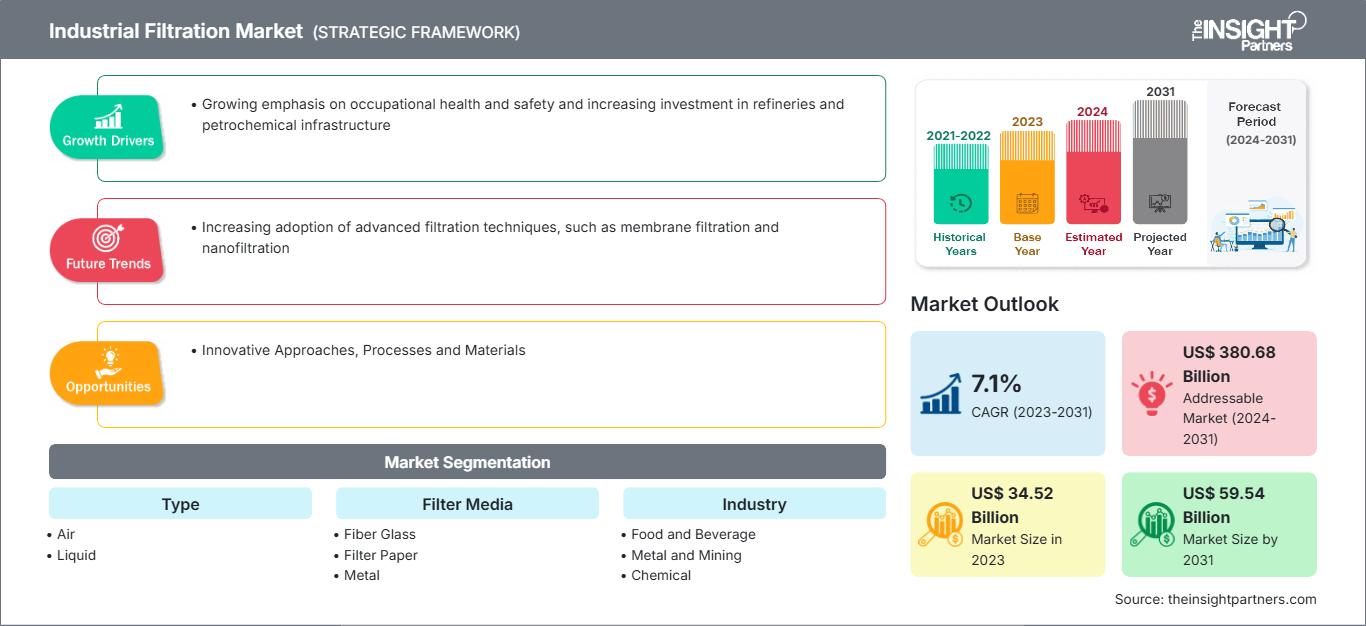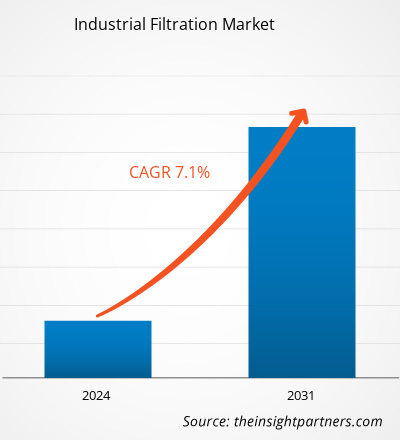Se prevé que el mercado de filtración industrial alcance los 59.540 millones de dólares estadounidenses en 2031, frente a los 34.520 millones de dólares estadounidenses en 2023. Se espera que el mercado registre una tasa de crecimiento anual compuesta (TCAC) del 7,1 % durante el período 2023-2031. La creciente adopción de técnicas de filtración avanzadas, como la filtración por membrana y la nanofiltración, probablemente seguirá siendo una tendencia clave en el mercado.
Análisis del mercado de filtración industrial
En los últimos años, el mercado de la filtración industrial ha experimentado un crecimiento significativo. Factores como la creciente industrialización y urbanización, el aumento de las operaciones industriales, el mayor énfasis en la salud y seguridad ocupacional, y la creciente concienciación y normativas sobre sostenibilidad ambiental son algunos de los que impulsan este crecimiento. Los enfoques, procesos y materiales innovadores han brindado oportunidades de crecimiento lucrativas para el mercado de la filtración industrial.
Panorama general del mercado de filtración industrial
La filtración industrial es un proceso mediante el cual las industrias filtran sus productos para eliminar residuos y otros desechos. Se centra en el secado de los residuos para su eliminación segura y en el refinamiento del producto final. La filtración es esencial para diversas industrias, como la minería, el gas natural, la gestión de residuos líquidos, el agua, el envasado de alimentos y bebidas, la generación de energía renovable, entre otras. Existen varios tipos de filtros industriales, clasificados según sus características mecánicas y físicas. Algunos ejemplos son los filtros de gravedad, los filtros de presión/vacío, los filtros de hojas y los filtros de vacío de tambor rotatorio.
Obtendrá personalización gratuita de cualquier informe, incluyendo partes de este informe, análisis a nivel de país y paquetes de datos de Excel. Además, podrá aprovechar excelentes ofertas y descuentos para empresas emergentes y universidades.
Mercado de filtración industrial: Perspectivas estratégicas

- Obtenga las principales tendencias clave del mercado que se describen en este informe.Esta muestra GRATUITA incluirá análisis de datos, que abarcarán desde tendencias de mercado hasta estimaciones y pronósticos.
Factores impulsores y oportunidades del mercado de filtración industrial
El creciente énfasis en la salud y seguridad ocupacional favorecerá al mercado.
En el dinámico mundo actual, es fundamental garantizar el bienestar de los trabajadores. Un lugar de trabajo seguro constituye la base de un entorno saludable y, además, impulsa la productividad y mejora la reputación corporativa. Garantizar la seguridad laboral implica la implementación de diversas medidas preventivas, políticas y procedimientos de seguridad para minimizar las lesiones, los accidentes y las enfermedades laborales. Con el fin de garantizar la seguridad en el trabajo, diversas industrias, como la manufacturera, la minera, la farmacéutica y otras, han invertido cada vez más en tecnologías de filtración avanzadas para proteger a sus empleados de partículas, sustancias químicas y humos nocivos.
Enfoques, procesos y materiales innovadores
Las averías de maquinaria constituyen uno de los mayores problemas de producción a los que se enfrentan los fabricantes. Contaminantes como el polvo, la escoria de soldadura, la neblina de aceite, las partículas de caucho procedentes de mangueras y juntas, la arena de las piezas fundidas y los residuos metálicos de los componentes mecanizados son las principales causas de estas averías. Tanto los costes de reparación como el tiempo de inactividad son elevados. A medida que los consumidores se vuelven más conscientes del impacto negativo de los contaminantes, aumenta la demanda de procesos y productos mejorados que ayuden a reducir el tiempo de inactividad, prolongar la vida útil del lubricante y disminuir los costes. En este contexto, las organizaciones están implementando cada vez más avances en filtración en tres áreas: diseños de filtros más duraderos, materiales de mayor rendimiento y monitorización automatizada de los filtros (Internet de las Cosas) para abordar estos problemas.
Análisis de segmentación del informe de mercado de filtración industrial
Los segmentos clave que contribuyeron a la elaboración del análisis del mercado de filtración industrial son el tipo, el medio filtrante y la industria.
- Según su tipo, el mercado de filtración industrial se divide en filtración de aire y de líquidos. El segmento de filtración de aire ostentó una mayor cuota de mercado en 2023.
- Según el tipo de medio filtrante, el mercado se segmenta en fibra de vidrio, papel de filtro, metal y tela no tejida. El segmento de tela no tejida ostentó la mayor cuota de mercado en 2023.
- En cuanto a la industria, el mercado se segmenta en alimentos y bebidas, metalurgia y minería, química, farmacéutica, generación de energía y otros. Se prevé que el segmento de alimentos y bebidas experimente el mayor crecimiento anual compuesto (CAGR) durante el período de pronóstico.
Análisis de la cuota de mercado de la filtración industrial por geografía
El alcance geográfico del informe sobre el mercado de filtración industrial se divide principalmente en cinco regiones: América del Norte, Asia Pacífico, Europa, Oriente Medio y África, y América del Sur y Central.
Se prevé que el mercado europeo de filtración industrial experimente un crecimiento significativo en el futuro próximo. Europa ha liderado la implementación de estrictas normativas y estándares ambientales para reducir el impacto de las emisiones industriales. Estas normativas hacen hincapié en el uso de materiales no tóxicos, la modificación de los métodos de fabricación y las técnicas de conservación. En consecuencia, las industrias europeas están adoptando cada vez más sistemas de filtración industrial para cumplir con estas normativas y reducir la contaminación, impulsando así el mercado regional de filtración industrial.
Perspectivas regionales del mercado de filtración industrial
Los analistas de The Insight Partners han explicado en detalle las tendencias y los factores regionales que influyen en el mercado de filtración industrial durante el período de previsión. Esta sección también analiza los segmentos y la geografía del mercado de filtración industrial en Norteamérica, Europa, Asia Pacífico, Oriente Medio y África, y Sudamérica y Centroamérica.
Alcance del informe de mercado de filtración industrial
| Atributo del informe | Detalles |
|---|---|
| Tamaño del mercado en 2023 | 34.520 millones de dólares estadounidenses |
| Tamaño del mercado para 2031 | 59.540 millones de dólares estadounidenses |
| Tasa de crecimiento anual compuesto global (2023 - 2031) | 7,1% |
| Datos históricos | 2021-2022 |
| período de previsión | 2024-2031 |
| Segmentos cubiertos | Por tipo
|
| Regiones y países cubiertos | América del norte
|
| Líderes del mercado y perfiles de empresas clave |
|
Densidad de los actores del mercado de filtración industrial: comprensión de su impacto en la dinámica empresarial
El mercado de filtración industrial está creciendo rápidamente, impulsado por la creciente demanda de los usuarios finales debido a factores como la evolución de las preferencias de los consumidores, los avances tecnológicos y una mayor conciencia de los beneficios del producto. A medida que aumenta la demanda, las empresas amplían su oferta, innovan para satisfacer las necesidades de los consumidores y aprovechan las nuevas tendencias, lo que impulsa aún más el crecimiento del mercado.

- Obtenga una visión general de los principales actores del mercado de filtración industrial.
Noticias y novedades recientes del mercado de filtración industrial
El mercado de filtración industrial se evalúa mediante la recopilación de datos cualitativos y cuantitativos tras una investigación primaria y secundaria, que incluye publicaciones corporativas importantes, datos de asociaciones y bases de datos. A continuación se enumeran algunos de los avances en el mercado de filtración industrial:
- Pall Corporation, líder mundial en el mercado de filtración industrial, separación y tecnología de purificación, presentará su tecnología de filtración y purificación de última generación en SEMICON West. Esta iniciativa estratégica responde a la creciente demanda de chips avanzados con mayor rendimiento y eficiencia energética, impulsada por la adopción cada vez mayor de dispositivos 5G, IA e IoT. (Fuente: Pall Corporation, Comunicado de prensa, julio de 2023)
- El Grupo MANN+HUMMEL, líder mundial en soluciones de filtración, ha adquirido recientemente una participación mayoritaria en Suzhou U-Air Environmental Technology. Esta iniciativa estratégica responde a la creciente demanda global de soluciones para un aire más limpio y busca fortalecer la presencia de MANN+HUMMEL en el mercado de filtración de aire de China y el Sudeste Asiático. La adquisición de Suzhou U-Air Environmental Technology permite a MANN+HUMMEL ampliar su cartera de productos y satisfacer la creciente demanda de soluciones de filtración de aire en la región. (Fuente: Grupo MANN+HUMMEL, Comunicado de Prensa, octubre de 2023)
Cobertura y resultados del informe de mercado de filtración industrial
El informe “Tamaño y pronóstico del mercado de filtración industrial (2021-2031)” proporciona un análisis detallado del mercado que abarca las siguientes áreas:
- Tamaño y pronóstico del mercado de filtración industrial a nivel mundial, regional y nacional para todos los segmentos clave del mercado cubiertos por el alcance.
- Tendencias del mercado de filtración industrial, así como la dinámica del mercado, como los impulsores, las restricciones y las oportunidades clave.
- Análisis detallado PEST/Cinco Fuerzas de Porter y SWOT
- Análisis del mercado de filtración industrial que abarca las principales tendencias del mercado, el marco global y regional, los principales actores, las regulaciones y los desarrollos recientes del mercado.
- Análisis del panorama industrial y de la competencia, que abarca la concentración del mercado, el análisis de mapas de calor, los principales actores y los desarrollos recientes del mercado de filtración industrial.
- Perfiles detallados de las empresas
- Análisis histórico (2 años), año base, pronóstico (7 años) con CAGR
- Análisis PEST y FODA
- Tamaño del mercado, valor/volumen: global, regional y nacional
- Industria y panorama competitivo
- Conjunto de datos de Excel
Informes recientes
Testimonios
Razón para comprar
- Toma de decisiones informada
- Comprensión de la dinámica del mercado
- Análisis competitivo
- Información sobre clientes
- Pronósticos del mercado
- Mitigación de riesgos
- Planificación estratégica
- Justificación de la inversión
- Identificación de mercados emergentes
- Mejora de las estrategias de marketing
- Impulso de la eficiencia operativa
- Alineación con las tendencias regulatorias




















 Obtenga una muestra gratuita para - Mercado de filtración industrial
Obtenga una muestra gratuita para - Mercado de filtración industrial